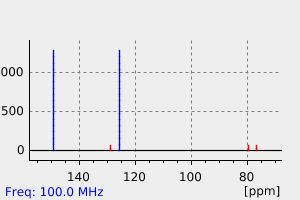1,4-二(吡啶-4-基)丁-1,3-二炔 | 91508-53-1
中文名称
1,4-二(吡啶-4-基)丁-1,3-二炔
中文别名
——
英文名称
4,4'-dipyridylbutadiyne
英文别名
1,4-bis(4-pyridyl)butadiyne;1,4-di(pyridin-4-yl)buta-1,3-diyne;4-(4-pyridin-4-ylbuta-1,3-diynyl)pyridine
CAS
91508-53-1
化学式
C14H8N2
mdl
——
分子量
204.231
InChiKey
BKRBETINLDNENR-UHFFFAOYSA-N
BEILSTEIN
——
EINECS
——
-
物化性质
-
计算性质
-
ADMET
-
安全信息
-
SDS
-
制备方法与用途
-
上下游信息
-
文献信息
-
表征谱图
-
同类化合物
-
相关功能分类
-
相关结构分类
物化性质
-
熔点:208-209 °C
-
沸点:385.9±30.0 °C(Predicted)
-
密度:1.21±0.1 g/cm3(Predicted)
计算性质
-
辛醇/水分配系数(LogP):2.2
-
重原子数:16
-
可旋转键数:3
-
环数:2.0
-
sp3杂化的碳原子比例:0.0
-
拓扑面积:25.8
-
氢给体数:0
-
氢受体数:2
上下游信息
-
上游原料
中文名称 英文名称 CAS号 化学式 分子量 4-乙炔基吡啶 4-pyridylacetylene 2510-22-7 C7H5N 103.123 2-甲基-4-(4-吡啶)-3-丁炔-2-醇 2-methyl-4-(4-pyridyl)-3-butyn-2-ol 55384-91-3 C10H11NO 161.203
反应信息
-
作为反应物:描述:1,4-二(吡啶-4-基)丁-1,3-二炔 在 sodiumsulfide nonahydrate 、 potassium hydroxide 作用下, 以 甲醇 为溶剂, 反应 2.0h, 生成 2,5-di(4-pyridyl)thiophene参考文献:名称:通过一锅 Sonogashira-Glaser 环化序列对 2,5-二(杂)芳基噻吩进行伪五组分合成。摘要:基于连续的一锅 Sonogashira-Glaser 偶联环化序列,合成了多种 2,5-二(杂)芳基噻吩,收率中等至良好。使用单一的 Pd/Cu 催化剂系统,无需进一步添加催化剂,并且使用容易获得、稳定的起始材料,从而为合成标题化合物提供了一条简洁高效的路线。这种从碘(杂)芳烃开始的新型伪五组分合成特别适合直接获取定义明确的噻吩低聚物,这在材料科学中具有特殊意义。DOI:10.3762/bjoc.7.174
-
作为产物:描述:4-碘吡啶 在 potassium fluoride 、 copper(l) iodide 、 trans-bis(triphenylphosphine)palladium dichloride 、 三乙胺 作用下, 以 甲醇 、 N,N-二甲基甲酰胺 为溶剂, 反应 17.5h, 生成 1,4-二(吡啶-4-基)丁-1,3-二炔参考文献:名称:通过一锅 Sonogashira-Glaser 环化序列对 2,5-二(杂)芳基噻吩进行伪五组分合成。摘要:基于连续的一锅 Sonogashira-Glaser 偶联环化序列,合成了多种 2,5-二(杂)芳基噻吩,收率中等至良好。使用单一的 Pd/Cu 催化剂系统,无需进一步添加催化剂,并且使用容易获得、稳定的起始材料,从而为合成标题化合物提供了一条简洁高效的路线。这种从碘(杂)芳烃开始的新型伪五组分合成特别适合直接获取定义明确的噻吩低聚物,这在材料科学中具有特殊意义。DOI:10.3762/bjoc.7.174
文献信息
-
Engineering Stacks of Aromatic Rings by the Interpenetration of Self-Assembled Coordination Cages作者:Yoshihiro Yamauchi、Michito Yoshizawa、Makoto FujitaDOI:10.1021/ja077783+日期:2008.5.1One-step quantitative self-assembly of aromatic towers consisting of seven to nine discretely stacked aromatic rings is achieved from 25-27 multicomponents via the interpenetration of two identical coordination cages.通过两个相同的配位笼的相互渗透,由 25-27 个多组分实现了由 7 到 9 个离散堆叠的芳环组成的芳香塔的一步定量自组装。
-
Syntheses and structures of dinuclear rhodium(I) complexes and 1-D zigzag-chain rhodium(I) co-ordination polymers bridged by rod-like bidentate nitrogen ligands †作者:Masahiko Maekawa、Kunihisa Sugimoto、Takayoshi Kuroda-Sowa、Yusaku Suenaga、Megumu MunakataDOI:10.1039/a907577a日期:——Novel dinuclear rhodium(I) complexes, [Rh2(2-bpbd)2(cod)2]X2 (X = BF4 1a, PF6 1b or ClO4 1c; cod = cycloocta-1,5-diene) and 1-D rhodium(I) co-ordination polymers with the linkage of square-planar rhodium(I) centers, [Rh(4-bpbd)(cod)]X}n (X = BF4 2a, PF6 2b or ClO4 2c) and [Rh(4-bpe)(cod)]X}n(X = BF43a, PF6 3b or ClO4 3c), were systematically synthesized using 1,4-bis(2-pyridyl)butadiyne (2-bpbd), 1,4-bis(4-pyridyl)butadiyne (4-bpbd) and trans-1,2-bis(4-pyridyl)ethylene (4-bpe). The structures of 1a, 2a, 2b and 3a were crystallographically characterized. In 1a each Rh atom is bridged by two N atoms of 2-bpbd to afford a unique dinuclear structure with an 18-membered Rh2N4C12 framework. In 2a, 2b and 3a, each Rh atom is bonded to two N atoms of 4-bpbd (2a and 2b) or 4-bpe (3a) and two CC bonds of cod in a square-planar geometry. The square-planar centers are in turn linked by 4-bpbd or 4-bpe ligands to form a 1-D zigzag-chain structure. The zigzag chains are located in parallel 9.6, 9.9 and 10.7 à apart in 2a, 2b and 3a, respectively, and no effective intermolecular interactions were found.新型的二核铑(I)配合物,[Rh2(2-bpbd)2(cod)2]X2(X = BF4 1a,PF6 1b或ClO4 1c;cod = 环辛-1,5-二烯)和具有平面正方形铑(I)中心连接的一维铑(I)配位聚合物,[Rh(4-bpbd)(cod)]X}n(X = 2a,PF6 2b或 2c)以及[Rh(4-bpe)(cod)]X}n(X = 3a,PF6 3b或 3c),采用1,4-双(2-吡啶基)丁二炔(2-bpbd)、1,4-双(4-吡啶基)丁二炔(4-bpbd)和反式-1,2-双(4-吡啶基)乙烯(4-bpe)系统合成。通过晶体结构分析,对1a、2a、2b和3a结构进行了表征。在1a中,每个Rh原子通过2-bpbd的两个N原子桥接,形成一个具有18元环的Rh2N4C12框架的独特二核结构。在2a、2b和3a中,每个Rh原子通过4-bpbd(2a和2b)或4-bpe(3a)的两个N原子和cod的两个碳碳键在一个平面正方形几何构型中连接。这些平面正方形的中心通过4-bpbd或4-bpe配体形成一个一维锯齿链结构。锯齿链分别位于彼此平行9.6、9.9和10.7 Å处,在2a、2b和3a中没有发现有效的分子间相互作用。
-
Self-Assembly Triangular and Square Rhenium(I) Tricarbonyl Complexes: A Comprehensive Study of Their Preparation, Electrochemistry, Photophysics, Photochemistry, and Host−Guest Properties作者:Shih-Sheng Sun、Alistair J. LeesDOI:10.1021/ja001677p日期:2000.9.1compounds featuring fac-Re(CO)3X (X = Cl or Br) as corners and linear bipyridyl bridging ligands have been prepared and characterized. Depending on the lengths as well as the bonding angles of the bridging ligands, the resulting geometries of these macrocyclic complexes are squares [ClRe(CO)3(μ-DPB)]4 (3) and [ClRe(CO)3(μ-AZP)]4 (4)}, triangles [BrRe(CO)3(μ-BPDB)]3 (6) and [BrRe(CO)3(μ-BPDDB)]3 (7)}, or已经制备并表征了一系列以 fac-Re(CO)3X(X = Cl 或 Br)为角和线性联吡啶桥联配体的自组装大环化合物。根据桥连配体的长度和键角,这些大环配合物的所得几何形状是正方形 [ClRe(CO)3(μ-DPB)]4 (3) 和 [ClRe(CO)3(μ -AZP)]4 (4)}、三角形 [BrRe(CO)3(μ-BPDB)]3 (6) 和 [BrRe(CO)3(μ-BPDDB)]3 (7)},或二聚体物种 [ClRe(CO)3(μ-BPET)]2 (5)}。提出了涉及可溶性中间体的自组装过程的一般机制。这些大环化合物的光物理性质由最低激发态的特性决定,这些态从金属到配体的电荷转移 (MLCT) 到配体局部化的 π → π* 或不同分子的 n → π* 跃迁。正方形 3 和三角形 6 和 7 在室温溶液中发光,而正方形 4 和二聚体 5 不发光。来自 MLCT 的能量转移机制激发
-
Screening Hofmann Compounds as CO<sub>2</sub> Sorbents: Nontraditional Synthetic Route to Over 40 Different Pore-Functionalized and Flexible Pillared Cyanonickelates作者:Jeffrey T. Culp、Catherine Madden、Kristi Kauffman、Fan Shi、Christopher MatrangaDOI:10.1021/ic301893p日期:2013.4.15A simple reaction scheme based on the heterogeneous intercalation of pillaring ligands (HIPLs) provides a convenient method for systematically tuning pore size, pore functionality, and network flexibility in an extended series of pillared cyanonickelates (PICNICs), commonly referred to as Hofmann compounds. The versatility of the approach is demonstrated through the preparation of over 40 different一个基于柱状配体(HIPL)异质插入的简单反应方案提供了一种方便的方法,可用于系统地调节通常被称为霍夫曼化合物的柱状氰基酮酸酯(PICNIC)扩展系列中的孔径,孔功能和网络柔性。该方法的多功能性通过制备40多种不同的PICNIC来证明,这些PICNIC的长度为约4至约15Å,并经多种官能团修饰,包括氟,醛,烷基胺,烷基,芳基,三氟甲基,酯,硝基,醚和非金属化的4,4'-联嘧啶。HIPL方法涉及将预形成的粉末状无水氰化镍聚合物薄片的悬浮液与适当的柱状配体在回流的有机溶剂中反应,2(CN)4 ] n网络成包含有机支柱配体的多晶三维多孔框架。初步研究表明,HIPL反应也适合形成Co(L)Ni(CN)4,Fe(L)Ni(CN)4和Fe(L)Pd(CN)4网络。这些材料对CO 2的吸附行为取决于柱长和柱官能度。几种化合物在CO 2的吸附和解吸过程中表现出结构上的柔性行为。有趣的是,新发现的柔性化合物
-
Synthesis and structural characterization of a monomeric di-copper-substituted silicotungstate [γ-H2SiW10O36Cu2(μ-1,1-N3)2]4− and the catalysis of oxidative homocoupling of alkynes作者:Kazuya Yamaguchi、Keigo Kamata、Syuhei Yamaguchi、Miyuki Kotani、Noritaka MizunoDOI:10.1016/j.jcat.2008.06.004日期:2008.8acetonitrile, benzonitrile, and 1,2-dichloroethane, showed that complex 1 was present as a monomer of the di-copper-substituted γ-Keggin silicotungstate. Complex 1 could act as an effective homogeneous catalyst for the oxidative homocoupling of various types of alkynes, including aromatic, aliphatic, and heteroatom-containing ones. The reaction possibly proceeds as follows: First, the ligand exchange具有双-μ - 1,1-叠氮基配体的双铜取代的γ - Keggin硅钨酸盐TBA 4 [ γ- H 2 SiW 10 O 36 Cu 2(μ -1,1-N 3)2 ](1,TBA在水性介质中合成=(四TBA =四-正丁基铵)。1的阴离子部分的晶体结构是基-基末端叠氮桥联双铜取代的γ - Keggin硅钨酸盐的单体。的NMR和CSI-MS谱1在乙腈,苄腈和1,2-二氯乙烷等有机溶剂中的分析表明,配合物1作为双铜取代的γ - Keggin硅钨酸盐的单体存在。配合物1可以作为有效的均相催化剂,用于各种类型的炔烃(包括芳族,脂族和含杂原子的炔烃)的氧化均偶联。反应可能如下进行:首先,配体交换在1中的叠氮基之间进行。 和炔基通过二铜(II)-炔基中间体与还原的铜(I)物种形成相应的二炔,然后还原的物种被分子氧再氧化,氧化的物种与炔反应生成炔基中间的。
表征谱图
-
氢谱1HNMR
-
质谱MS
-
碳谱13CNMR
-
红外IR
-
拉曼Raman
-
峰位数据
-
峰位匹配
-
表征信息
同类化合物
(S)-氨氯地平-d4
(R,S)-可替宁N-氧化物-甲基-d3
(R)-(+)-2,2'',6,6''-四甲氧基-4,4''-双(二苯基膦基)-3,3''-联吡啶(1,5-环辛二烯)铑(I)四氟硼酸盐
(R)-N'-亚硝基尼古丁
(R)-DRF053二盐酸盐
(5E)-5-[(2,5-二甲基-1-吡啶-3-基-吡咯-3-基)亚甲基]-2-亚磺酰基-1,3-噻唑烷-4-酮
(5-溴-3-吡啶基)[4-(1-吡咯烷基)-1-哌啶基]甲酮
(5-氨基-6-氰基-7-甲基[1,2]噻唑并[4,5-b]吡啶-3-甲酰胺)
(2S,2'S)-(-)-[N,N'-双(2-吡啶基甲基]-2,2'-联吡咯烷双(乙腈)铁(II)六氟锑酸盐
(2S)-2-[[[9-丙-2-基-6-[(4-吡啶-2-基苯基)甲基氨基]嘌呤-2-基]氨基]丁-1-醇
(2R,2''R)-(+)-[N,N''-双(2-吡啶基甲基)]-2,2''-联吡咯烷四盐酸盐
(1'R,2'S)-尼古丁1,1'-Di-N-氧化物
黄色素-37
麦斯明-D4
麦司明
麝香吡啶
鲁非罗尼
鲁卡他胺
高氯酸N-甲基甲基吡啶正离子
高氯酸,吡啶
高奎宁酸
马来酸溴苯那敏
马来酸氯苯那敏-D6
马来酸左氨氯地平
顺式-双(异硫氰基)(2,2'-联吡啶基-4,4'-二羧基)(4,4'-二-壬基-2'-联吡啶基)钌(II)
顺式-二氯二(4-氯吡啶)铂
顺式-二(2,2'-联吡啶)二氯铬氯化物
顺式-1-(4-甲氧基苄基)-3-羟基-5-(3-吡啶)-2-吡咯烷酮
顺-双(2,2-二吡啶)二氯化钌(II) 水合物
顺-双(2,2'-二吡啶基)二氯化钌(II)二水合物
顺-二氯二(吡啶)铂(II)
顺-二(2,2'-联吡啶)二氯化钌(II)二水合物
韦德伊斯试剂
非那吡啶
非洛地平杂质C
非洛地平
非戈替尼
非布索坦杂质66
非尼拉朵
非尼拉敏
雷索替丁
阿雷地平
阿瑞洛莫
阿扎那韦中间体
阿培利司N-6
阿伐曲波帕杂质40
间硝苯地平
间-硝苯地平
镉,二碘四(4-甲基吡啶)-
锌,二溴二[4-吡啶羧硫代酸(2-吡啶基亚甲基)酰肼]-







